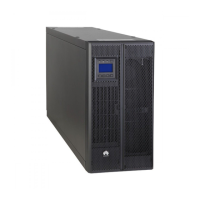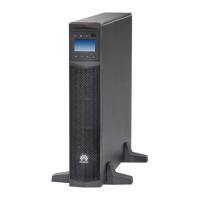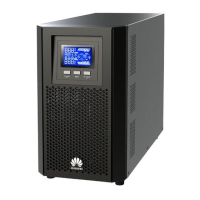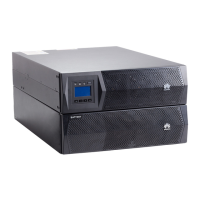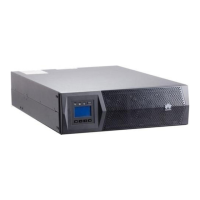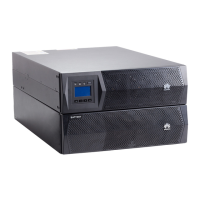5.2 Starting a UPS
● If no buttons are pressed for more than 30s in UPS setting mode, the LCD
home screen is displayed.
● If no battery packs are connected to the UPS with long backup time, the buzzer
keeps buzzing.
● Charge the batteries for 5 hours before using them for the
rst time.
Otherwise, the battery discharge time will decrease.
● The UPS automatically checks the batteries once every week, and generates
alarms if any faults are detected.
● When the mains is connected and the UPS with long backup time is connected
to battery packs or batteries for the
rst time, perform a battery self-check
manually by holding down the ON/MUTE button on the front panel for 5s.
Then, the UPS transfers to battery self-check mode and performs a battery
shallow discharge test. After 10s, the UPS automatically transfers back to
normal mode.
● The charge current is
xed at 4 A for the UPS with long backup time. If the UPS
needs to connect to external battery packs or battery strings, the total battery
capacity must exceed 18 Ah. Otherwise, batteries may be damaged. If the
capacity of external battery packs or battery strings to be connected exceeds 40
Ah, it is recommended that external chargers be purchased and added to
increase the charge current. Otherwise, the charge time will be prolonged.
● The number of batteries are
xed: 2 built-in batteries for the 1 kVA UPS with
standard backup time, 4 built-in batteries for the 2 kVA UPS with standard
backup time, 6 built-in batteries for the 3 kVA UPS with standard backup time,
3 external batteries in each string for the 1 kVA UPS with long backup time, 6
external batteries in each string for the 2 kVA UPS with long backup time, and
8 external batteries in each string for the 3 kVA UPS with long backup time.
● For a UPS with standard backup time, the battery capacity is
xed at 9 Ah by
default, and the charge current is xed at 1 A. The battery capacity of a UPS
with long backup time is the total capacity of all battery strings. Set the battery
capacity based on site requirements. The default battery capacity is 18 Ah. For
example, if the 3 kVA UPS with long backup time is connected to two parallel 9
Ah/12 V battery strings each with eight batteries connected in series, the
battery capacity is 9 Ah + 9 Ah = 18 Ah. This parameter
aects the backup time
calculated by the UPS. Incorrect setting will lead to inaccurate backup time
displaying on the LCD.
● Exercise caution when manually shutting down the UPS inverter for transferring
to bypass mode, or when adjusting the UPS output voltage level or output
frequency. Doing so may
aect the power supply to equipment.
● Exercise caution when setting battery parameters. Incorrect settings will aect
the power supply and battery lifespan.
UPSJZ-T-(1 kVA–3 kVA)
User Manual 5 Operations
2022-08-15 77

